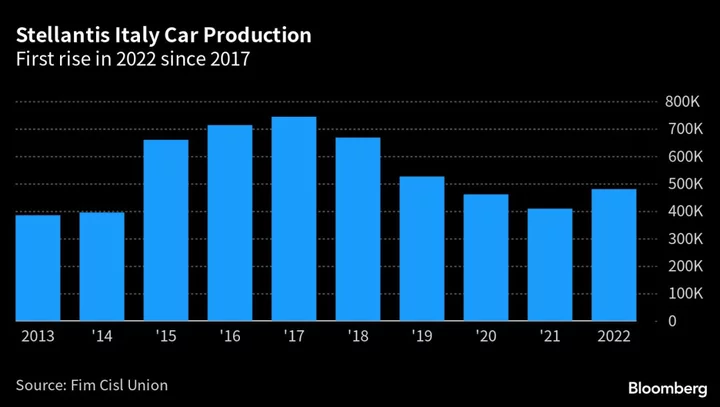Stellantis NV Chairman John Elkann credits former Fiat boss Sergio Marchionne with salvaging Italy’s auto industry and rejects years of criticism over the manufacturer progressively paring back its presence in the country.
“Sergio was a patriot in the highest sense of the word,” Elkann, 47, said in an interview for the latest edition of the biography of the late Marchionne, who ran the Italian carmaker from 2004 until his death in 2018. As Fiat’s chief executive officer, Marchionne and Elkann saved Fiat from near bankruptcy and combined it with US manufacturer Chrysler, turning two struggling regional players into one of the world’s biggest auto producers.
“Our battles were always for Italy, never battles against Italy,” Elkann said at the Agnelli Foundation headquarters in Turin, which houses the villa of his great-great grandfather Giovanni Agnelli, who founded Fiat with a group of investors in 1899.
Stellantis, set up in 2021 through the combination of Fiat Chrysler and PSA Group, is feeling heat from organized labor groups that’s reminiscent of pressure they put on Marchionne. Italy’s left-wing Fiom union has criticized the carmaker over a series of so-called voluntary exits, as it looks to shed as many as 2,000 jobs this year, about 4.3% of its Italian workforce. The union claims Stellantis has cut 7,000 positions in Italy in the last three years.
Elkann insists that without the current strategy — which dates back to Marchionne and envisages building a global leader strong enough to survive the disruption of electrification — the company’s domestic plants would have been at existential risk.
“Stellantis is the evolution of Sergio’s vision: the need for mergers in the car industry to avoid duplication of costly investments required for new technologies,” Elkann said in a late February interview for the book. “Without the creation of Stellantis, all the investments we are making in Italy — from the Mirafiori electric hub to the battery plant in Termoli — would not have been possible.”
Carmakers have been grappling with inflation and supply chain disruption as they retool factories to transition to battery-powered cars, prompting cost-cutting drives and job cuts. EVs typically require about 30% less labor than gasoline burners.
Output Rises
But while car production in Italy has been shrinking for decades after peaking at almost 2 million vehicles in 1989, when Fiat was mostly a domestic player, Stellantis’ output rose 17% last year to about 480,000 cars, according to the FIM union.
The trend continued in the first quarter of this year, with production increasing 11% to 138,210 vehicles. That’s also up 1.4% from the first quarter of 2019, before the pandemic.
Stellantis has stepped up production of the electric version of its Fiat 500 small car, adding a Saturday shift at its Turin facility and bringing in workers from other plants. The company is planning to make more than 100,000 units this year, up from 77,500 in 2022, the union said.
Still, workers from the Fiom union held a strike at Stellantis’ Pomigliano plant in southern Italy earlier this month, slowing production of subcompact Pandas and Alfa Romeo SUVs. The union is pushing for better working conditions as output grows.
Stellantis redistributed more than €2 billion ($2.2 billion) to its employees worldwide based on last year’s record annual results, but CEO Carlos Tavares has cautioned the company may have to further adapt its industrial footprint in the US and Europe due to the costs of shifting to EVs.
In Elkann’s view, Stellantis would not have been possible without Marchionne’s efforts to change Fiat and make it less dependent on its home country and Europe.
“He created a revolution that only a true outsider like Sergio could bring about,” the leader of the Agnelli family said.
— Adapted from Sergio Marchionne. Nuova Versione by Tommaso Ebhardt, published in Italian by Sperling & Kupfer

